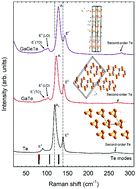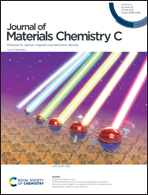Anomalous Raman modes in tellurides†
Abstract
Two anomalous broad bands are usually found in the Raman spectrum of bulk and 2D Te-based chalcogenides, which include binary compounds, like ZnTe, CdTe, HgTe, GaTe, GeTe, SnTe, PbTe, GeTe2, As2Te3, Sb2Te3, Bi2Te3, NiTe2, IrTe2, and TiTe2, as well as ternary compounds, like GaGeTe, SnSb2Te4, SnBi2Te4, and GeSb2Te5. Many different explanations have been proposed in the literature for the origin of the anomalous broad bands in tellurides, usually located between 119 and 145 cm−1. They have been attributed to the intrinsic Raman modes of the sample, to oxidation of the sample, to the folding of Brillouin-edge modes onto the zone center, to the existence of a double resonance, like that of graphene, or to the formation of Te precipitates. In this paper, we provide arguments to demonstrate that such bands correspond to clusters or precipitates of trigonal Te in the form of nanosize or microsize grains or layers that are segregated either inside or at the surface of the samples. Several mechanisms for Te segregation are discussed and sample heating caused by excessive laser power during Raman scattering measurements is emphasized. Besides, we show that anomalous Raman modes related to Se precipitates also occur in selenides, thus providing a general vision for better characterization of selenides and tellurides by means of Raman scattering measurements and for a better understanding of chalcogenides in general.



 Please wait while we load your content...
Please wait while we load your content...